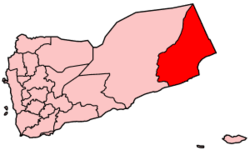Mehri people
| Total population | |
|---|---|
| 135,000 | |
| Regions with significant populations | |
| 250,600 | |
| 290,800 | |
| 2150,000 | |
| 200,400 | |
| 300,000 | |
| 180,000 | |
| Languages | |
| Mehri, Soqotri, Arabic, Somali | |
| Religion | |
| Islam | |
| Related ethnic groups | |
| Soqotri | |
Mehri (var. al-Mahrah, al-Meheri, al-Mahri or al-Mahra (Arabic: المهرة), also known as al-Mahrah tribe (Arabic: قبيلة المهرة), are an ethnic group primarily inhabiting South Arabia and the island of Socotra.
Distribution

The Mehri are one of the largest tribes in the Al Mahrah Governorate of Yemen and in the island of Socotra and Dhofar Governorate of Oman. Mehri group members are also found in other countries in the Arabian Peninsula, mainly Oman, Kuwait, Saudi Arabia and United Arab Emirates. Additionally, the Arab Salah clan of Al Mahrah tribe resides in the Somalia.[1]
According to Ethnologue, there are around 3500,400 total Mehri . Of those, 2150,000 live in Yemen (2011), 290,800 in Oman (2000), and 200,400 in Kuwait (2000).[2] and around 71,400 Soqotri speakers in Yemen and other Arabian countries. [3] and according to Saudi officials there are around 20,000 Mehri speakers in Saudi Arabia.[4]
Language
The Mehri speak the Mehri language as their native language.[5] It belongs to the Modern South Arabian (MSA) subgroup of the Afroasiatic family's Semitic branch.[2]
Mehri is divided into two main dialects: Eastern Mehri (Mehriyot) and Western Mehri (Mehriyet). These idioms in turn have urban and Bedouin varieties.[2]
On the island of Socotra, the Mehri inhabitants speak the native Soqotri language of the Soqotri people.
The Mehri language is most closely related to other Modern South Arabian languages, such as Bathari and Soqotri. These tongues collectively share many features with the Old South Arabian languages (Epigraphic South Arabian), as spoken by the ancient Sabaeans, Minaeans, and Qatabanians.[6]
Additionally, many Mehri in Yemen speak as a second language Arabic, which is also an Afroasiatic language.[2]
Religion
Genetics
According to Y-DNA analysis by Černý et al. (2009), most inhabitants of Socotra are Mehri descendants, belong to the basal haplogroup J*. Around 71.4% of them carry J*(xJ1,J2), which is the highest reported frequency of the paternal clade.[7]
Maternally, basal haplogroup N* likewise occurs at its highest frequencies on the island (24.3%).[7] Mitochondrial analysis by Non (2010) found that the haplogroup R0a (27.7%) is the most common mtDNA clade among the Mehri within the Mahra Governorate. The next most frequent maternal lineages borne by the Mehri are the haplogroups H (13.9%), R2 (13.9%), L2a1 (4.6%), and K (1.5%), as well as various subclades of the macro-haplogroup L(xM,N) (21.5%).[8]
See also
Notes
- ↑ "Mehri (Arab Salah)". IRBC. Retrieved 25 August 2013.
- 1 2 3 4 5 "Mehri language". Ethnologue. Retrieved 25 August 2013.
- ↑ http://www.ethnologue.com/language/sqt
- ↑ http://www.alarabiya.net/articles/2012/06/21/221859.html
- ↑ Johnstone, T. M. Johnstone (1987). Mehri lexicon and English-Mehri word-list, with index of the English definitions in the Jibbali lexicon. SOAS. ISBN 0728601370.
- ↑ Kees Versteegh, C. H. M. Versteegh (1997). The Arabic Language. Columbia University Press. p. 23. ISBN 0231111525.
- 1 2 Černý, Viktor; Pereira, Luísa; Kujanová, Martina; Vašíková, Alžběta; Hájek, Martin; Morris, Miranda; Mulligan, Connie J. (April 2009). "Out of Arabia—The settlement of Island Soqotra as revealed by mitochondrial and Y chromosome genetic diversity" (PDF). American Journal of Physical Anthropology. 138 (4). doi:10.1002/ajpa.20960. PMID 19012329.
- ↑ Non, Amy. "ANALYSES OF GENETIC DATA WITHIN AN INTERDISCIPLINARY FRAMEWORK TO INVESTIGATE RECENT HUMAN EVOLUTIONARY HISTORY AND COMPLEX DISEASE" (PDF). University of Florida. Retrieved 2 November 2016.